Wildlife and Grazing: Birds and Herds
Grazing Season of Use Effects on Sagebrush-obligate Songbirds
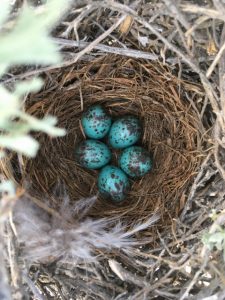
Population declines of sagebrush-obligate birds, including Brewer’s sparrow, greater sage-grouse, sagebrush sparrow, and sage thrasher, have occurred since the 1950’s in the Great Basin. While not a primary threat, livestock grazing is the predominant use of sagebrush habitat. However, there is no published literature from a rigorous comparison of direct or indirect effects of livestock grazing on sage-grouse or sagebrush-obligate songbirds.
- Status: We are currently in the process of writing a final publication including data for the full five years of the study, which includes one year of pre-treatment data (2017) and four years post-treatment data (2018-2021). This final publication will tie together the effects of weather, predator activity, grazing and vegetation on songbird nest survival, nest density and productivity (number of birds fledged from nest). Four publications are complete and available open source.
- Completed publications (click buttons below to read):
- Weather explains differences in sagebrush-obligate songbird nest success under various grazing regimes (2022)
- Effects of Dormant Season and Contemporary Spring-Summer Grazing on Plant Community Composition in the Sagebrush Ecosystem (2025)
- Nest predators of sagebrush-obligate songbirds in the Northern Great Basin (2025)
- Effects of Cattle Grazing on Food Web Dynamics: Meso-predators and Rodents in a Sagebrush Ecosystem (2025)
Completed MS thesis (click to access resources):
A Rangeland Mosaic: Sage-grouse, Cattle, and Predators
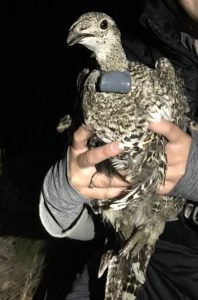
Very little is known about potential benefits or threats of livestock grazing on sage-grouse habitat and populations. This project, located in Wyoming, is investigating how cattle presence on the landscape may affect local mammalian and avian sage-grouse predators. It is suspected that there may be some indirect interactions between livestock and avian predators, which may differ from interactions between livestock and mammalian predators. For example, some unpublished data out of Wyoming suggests higher golden eagle and raven abundances near pastures with domestic sheep.

- Status: PhD candidate Kayla Ruth successfully defended her dissertation: Livestock grazing effects on greater sage-grouse ecology: Integrating habitat selection, predator dynamics and reproductive success in Wyoming’s Bighorn Basin. Kayla is currently revising her thesis to publish.
- Completed publications:
- PhD dissertation coming soon
Wildlife at Risk
Influence of Weeds, Fire, and Ravens on Sage-Grouse in Baker and Malheur counties
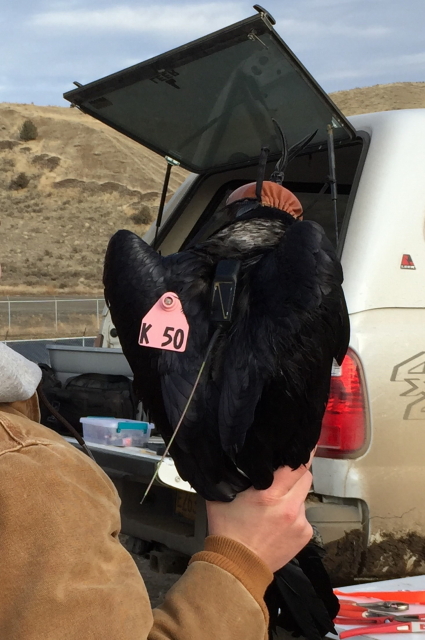
Federal, private, and state stakeholders are concerned that high raven density has contributed to sage-grouse decline in the Baker Sage-grouse Priority Area for Conservation (PAC). Thus, we are evaluating sage-grouse and raven interactions in (1) the Baker PAC, where lethal removal of ravens has been proposed, (2) a PAC in Malheur County proposed to have non-lethal manipulation of ravens, and (3) three reference PACs in Malheur County. We are simultaneously assessing the effect of wildfire and invasive annual grasses on sage-grouse habitat use and demographic rates.
- Status: Two phD students (Lindsey Perry and Terrah Owens) and one masters student (Richard Rich) successfully completed and defended their dissertations/thesis. Data collection will occur for 1-2 more years (2026-2027) for the final year or two of lethal raven treatments. Several manuscripts are in progress or in revision and anticipated in the next couple years. Completed publications are listed below.
- Completed publications:
- A novel technique to improve capture success of common ravens (2021)
- Landscape configuration impacts the area of spring space use and survival of female sage-grouse (2024)
- Anthropogenic subsidies and wildfire influence density, occupancy, and species interactions of three avian predators (2025)
Completed Dissertations and Theses (click to access resources)
Wildlife Trends: Human, Environment or Both?
Factors Driving Greater Sage-Grouse Trends in the Eastern Portion of Their Range: Anthropogenic, Fire, Habitat, Hunting, Ravens, and Weather
Degradation of sagebrush habitat has occurred throughout the range of sage-grouse. Areas with greater loss of sagebrush habitat are avoided by sage-grouse and are congruent with lower demographic rates and lek extirpation. We are simultaneously evaluating the relative importance of habitat and potential predation with numerous anthropogenic, fire, habitat, hunting regulations, raven numbers, weather factors, and prevalence of West Nile virus on lek trends of sage-grouse populations in the eastern range of sage-grouse.
- Completed publications (click below to access resources):
- Influence of environmental change, harvest exposure, and human disturbance on population trends of greater sage-grouse (2021)
- Changes in hunting season regulations (1870s–2019) reduce harvest exposure on greater and Gunnison sage-grouse (2021)
- Increased abundance of the common raven within the ranges of greater and Gunnison sage-grouse (2021)
Sage-grouse movement responses to human activities, structures, non-native grazers, and predators
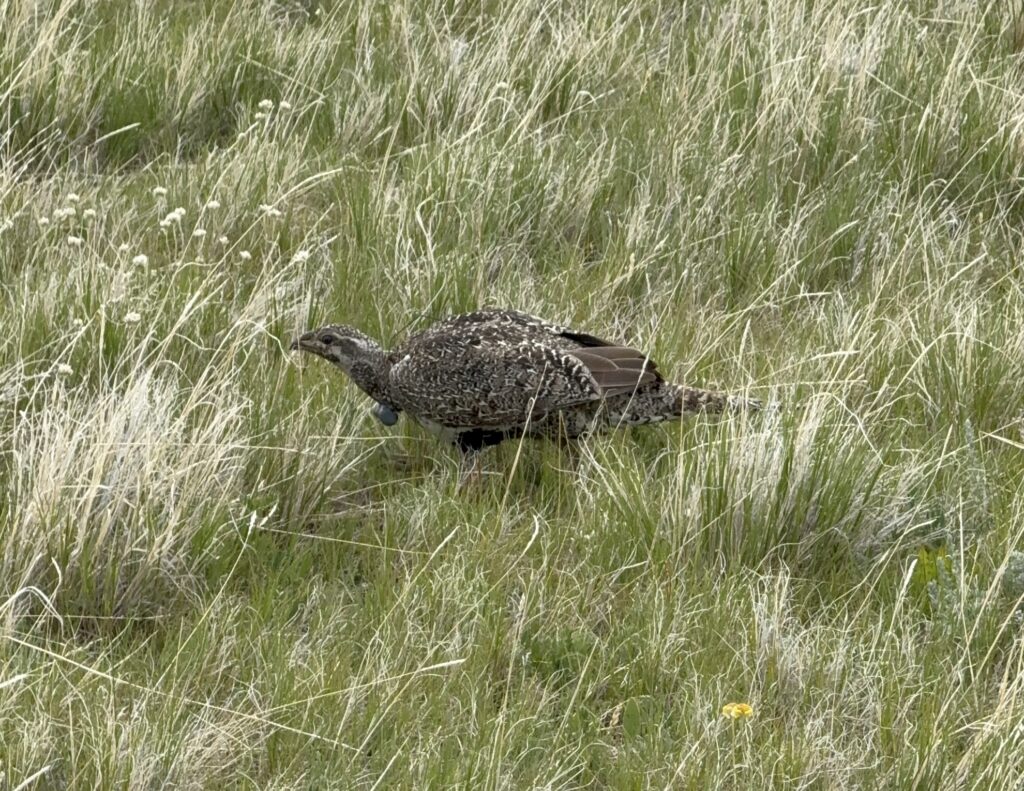
While broad-scale delineation of seasonal habitats and factors influencing habitat selection are well underway across the distribution of sage-grouse, there currently is little information on factors influencing movement and connectivity within and among seasonal habitats. Understanding what factors limit (e.g., perceived or physical barriers) or promote sage-grouse movement in and among seasonal habitats is essential to help management agencies increase or maintain the amount of functionally available habitat and promote sustainable populations.
This project aims to leverage 12 years of existing sage-grouse location data together with ongoing data collection in Wyoming’s Bighorn Basin to answer questions about factors inhibiting or promoting movement of sage-grouse among seasonal habitats.
Status: A new master’s student has completed the first year of new data collection on this project. Analysis will happen concurrently.
Steens Mountain Area Wildlife Habitat Study
Impact of Juniper Expansion and Removal in Aspen and Riparian Areas on Wildlife Species
We have completed year four of a study to understand how juniper removal in aspen, riparian, and sagebrush vegetation types influences sensitive wildlife. We are specifically interested in the impact removal has on mule deer and avian species. The effect of removing juniper on songbirds and mule deer has been previously studied in sagebrush ecosystems, but not in aspen and riparian areas within sagebrush. These areas provide critical resources and support a large diversity of birds despite their relatively small size. Additionally, juniper removal has not been assessed in relation to interactive effects with avian predator abundance. Our project will take the first step in this assessment by gathering data regarding avian predator and habitat relationships. We will also integrate analyses with an ongoing study in Baker and Malheur counties (discussed above) in Oregon. This will increase sample size and interpretations regarding avian ecology in the sagebrush ecosystem. Information from this project will help fill knowledge gaps and inform management decisions.
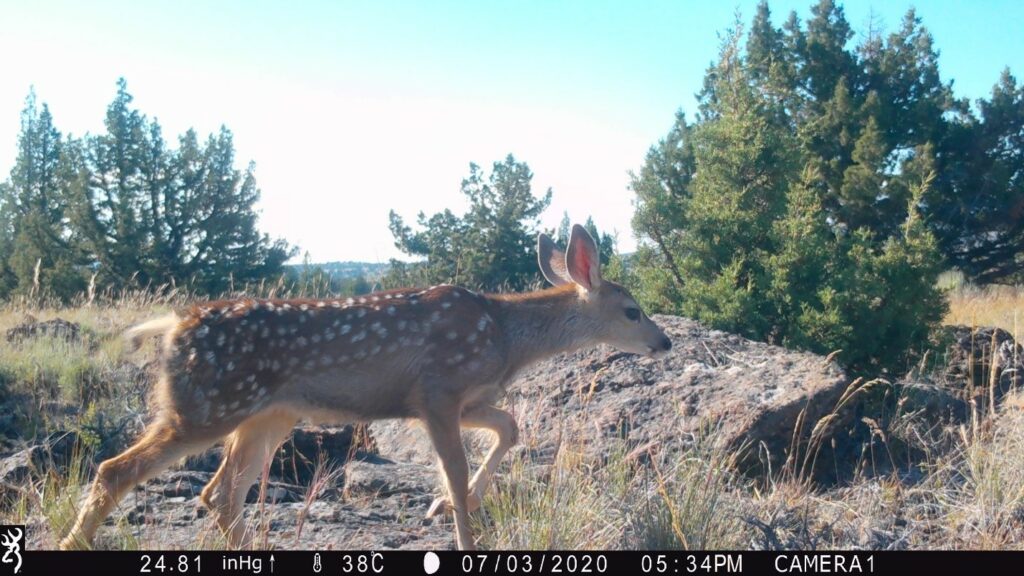

- Status: We have completed six years of data collection (two years of pre-treatment data in 2019 and 2020 and four years of post-treatment data in 2021-2024). Masters student Cara Christensen successfully completed and defended her thesis. The thesis chapters have been submitted to journals for peer-review and are currently undergoing revisions.
Anticipated publications:
- Summer mule deer occupancy across shrub and mixed juniper-aspen plant communities in the sagebrush ecosystem
- Juniper and aspen plant communities differentially affect tree-associated birds in the sagebrush ecosystem
- Seasonal mule deer activity or abundance across gradients of juniper cover and removal
- Bird community changes across a juniper gradient and in response to juniper removal
Completed MS thesis (click to access resources)
Project information and videos
Use of Machine Learning and Autonomous Recording Units to Monitor Avian Call Density Following Western Juniper Removal
We are currently using the machine learning based program BirdNET Analyzer to review recordings collected by autonomous recording units placed across Steen’s Mountain and Eastern Oregon’s sagebrush habitat. Selected recorder locations have a history of invasive western juniper removal by federal and state land management organizations. By analyzing these recordings, we hope to better understand the impact juniper removal has on avian call density.
The impact of western juniper removal on avian species has been studied previously, but few researchers have employed machine learning as a tool to monitor the response of avian species to juniper management. Even fewer have focused on the response of breeding sparrow species, especially of the “habitat generalist” vesper sparrow.
As the use of machine learning based analysis in bioacoustics research is still in its early years, this study aims to reinforce the capabilities and benefits associated with the use of programs like BirdNET Analyzer and autonomous recording units. This study will also expand our knowledge of avian behavior and sagebrush ecosystem management.
Status: All sound recording have been collected and we have a new MSc graduate student on board who is currently analyzing sound recordings with BirdNET Analyzer.
Avian Predator Occupancy and Diet at Communication Sites in Sage-Grouse Habitat

Studies have shown that sage-grouse avoid tall structures and both transmission lines and cellular towers have been linked to sage-grouse lek abandonment. These structures facilitate nesting and perching of avian predators of sage-grouse and their nests. We are conducting a field study to determine how the design, arrangement, and location of cellular/communication and transmission towers influences nesting and perching of ravens and other avian predators. We are assessing the prey composition of predators nesting at towers by Next-generation genetic sequencing of fecal samples, pellets, and prey items gathered from predator nests. We aim to assess prey composition and to determine the extent to which sage-grouse and/or other sensitive species make up diets of human subsidized avian predators.
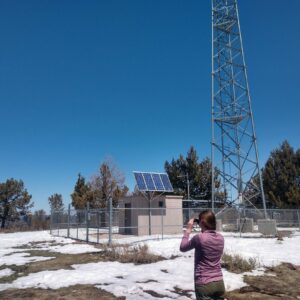
Status: We are in the data collection phase of this multi-year research project.
Identifying Critical Winter Wildlife Habitat
Identification of Winter Concentration Areas for Sage-Grouse in Wyoming: Abundance and Resource Selection.

Availability and use of winter habitat by sage-grouse can influence populations but is often overlooked when prioritizing areas for sage-grouse conservation. Wyoming has identified the need to delineate winter concentration areas (WCAs), which have been defined as areas with consistently >50 sage-grouse during the winter. This study was designed to detect locations of unknown WCAs while assessing abundance and resource selection to better understand sage-grouse use of winter habitats.
Wildlife Conservation: The Umbrella Approach
Effectiveness of Sage-grouse as an *Umbrella Species for Sagebrush-obligate Songbirds

Sagebrush habitat management relies heavily on known biology of sage-grouse. However, a knowledge gap persists surrounding the efficacy of sage-grouse as an umbrella species. Comparisons of population trends and reproductive success of sagebrush-obligate songbirds and sage-grouse will greatly inform future conservation actions. At present, there is little published literature on sagebrush-obligate songbird ecology and population status in the western range of the sagebrush biome. Outcomes of this study will help management agencies and private land owners improve sage-grouse habitat and monitor co-occurring sagebrush wildlife.
Status: Master’s student Alan Harrington successfully defended his thesis: “Assessing Sagebrush-obligate Songbird Abundance: Considerations of Landscape-level Threats and Umbrella Species Efficacy”. The publication is awaiting publication of sage-grouse variables from the eastern Oregon Raven/Sage-grouse project described above to be included in this analysis. Anticipated re-analyses in 2026 and publication in 2027.
Anticipated publications: Evaluating sagebrush-obligate songbird abundance under the greater sage-grouse umbrella; Sagebrush-obligate songbird productivity in relation to greater sage-grouse use vs available locations
Definitions: *Umbrella Species—an umbrella species is defined as a species whose conservation is expected to confer protection to a large number of naturally co‐occurring species.
Completed MS thesis
Sage-Grouse and Predators in “Core” Areas
Habitat Quality of Sage-Grouse Core Areas Relative to Avian and Mammalian Predators.

While human development influences sage-grouse, development also increases subsidies for avian and mammalian predators. High predator abundance can negatively influence sage-grouse demographic rates. Wyoming’s Sage-Grouse Core Area Policy added protections to important habitat for sage-grouse by reducing human development, and Core Areas have maintained higher sage-grouse trends compared to Non-Core Areas. We are comparing predator abundance within and outside Core Areas.
- Status: Master’s student Claire Revekant successfully defended her master’s thesis: “Comparison of Common Ravens in Sage-grouse Core and Non-Core Areas: Assessing Predator Densities Related to Anthropogenic Features.” Thesis chapters are currently being revised for submission to peer-refereed journals.
